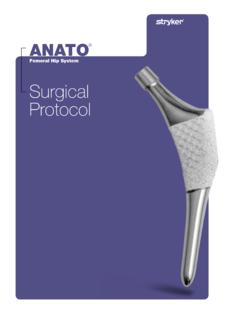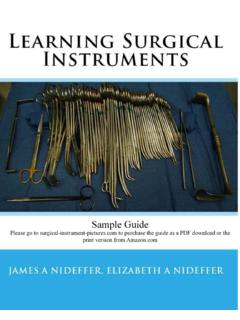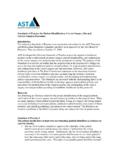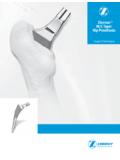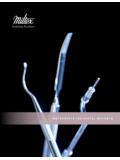Transcription of Tria thlon PKR Pa rtial Knee Resu rfacing Surgical …
1 Triathlon PKRP artial knee ResurfacingSurgical ProtocolTable of ContentsAcknowledgments ..4 Introduction ..4 Procedural Summary/Highlights ..5 Tibial Preparation ..8 Excision of Osteophytes ..8 Assembling the Ankle Clamp ..9 Attaching the Ankle Clamp ..10 Flexion/Extension Alignment (Tibial Slope) ..11 Varus/Valgus Adjustment ..11 Tibial Resection Level ..12 Sagittal Resection and Rotational Alignment ..13 Transverse Tibial Resection ..13 Before Removing the Tibial Resection Guide ..13 Femoral Preparation ..15 Distal Resection ..15 Alignment Check ..16 Posterior and Chamfer Resections ..17 Sizing and Trialing ..19 Tibial Sizing ..19 Femoral Trialing ..20 Trial Reduction ..21 Femoral Peg Preparation ..21 Tibial Peg Preparation ..22 Cementation ..23 Tibial Cementation ..23 Femoral Cementation ..23 Tibial Insert ..24 Alternate Femoral Preparation.
2 25 Triathlon PKRS urgical ProtocolAcknowledgmentsSpecial thanks to all those surgeons involved in the design and development of theTriathlon PKR Partial knee Resurfacing is a fixed bearing unicompartmental knee thatblends the ease of a measured resection system with the control of a ligamenttension restoring gap balancing system. The single radius design of the TriathlonPKR implant is designed to produce more stable, natural knee motion by couplingthe ability to restore ligament tension and balance flexion and extension gaps.>The femoral implant has a single radius from 10 of flexion through 110 offlexion and is equally 7mm thin posteriorly and distally. This design allows forgap balancing in only a few simple steps.>The Triathlon PKR balances flexion and extension gaps by varying the distalresection. In the Triathlon PKR System the posterior resection remains a fixed7mm, while the distal resection is varied to accommodate degenerative changesof the PKRS urgical Protocol45 Procedural Summary/Highlights1 Tibial Resection2 Assess Flexion Gap3 Assess Extension Gap4 Verify Alignment5 Distal Resection6 Posterior/ChamferResection7 Trialing8 Final Preparation9 CementationTriathlon PKRS urgical Protocol6 IndicationsThe Triathlon PKR components are for use inunicompartmental knee arthroplasty as a result of: Moderately disabling joint disease of the kneeresulting from painful osteo- or post traumaticarthritis.
3 Revision of previous unsuccessful surgicalprocedures, either involving, or not involving,previous use of a unicompartmental kneeprosthesis. As an alternative to tibial osteotomy in patientswith unicompartmental osteoarthritis. Where bone stock is of poor quality or inadequatefor other reconstructive techniques as indicatedby deficiencies of the femoral components are intended for implantationwith bone include: Patient has an active or suspected latent infectionin or about the knee joint. Patient has a known sensitivity to devicematerials. Patient s bone stock is compromised by diseaseand/or infection, or prior implantation whichcannot provide adequate support and/or fixationcannot be provided to the prosthesis. Patients with inflammatory arthritis. Patients with major deformity affecting themechanical axis of the knee or neuromusculardisorders compromising motor control and/orstability.
4 Any mental neuromuscular disorder, which wouldcreate an unacceptable risk of prosthesisinstability, prosthesis fixation failure orcomplications in post-operative care. Skeletal immaturity. Ligamentous instability such that the post-operative stability afforded by theunicompartmental knee prosthesis would becompromised such as multidirectional/ACLinstability. Untreated damage to the contralateralcompartment or the ipsilateral knee not beingreplaced by a prosthesis. Untreated deterioration or destruction of thepatello-femoral joint. Severe deformity and/or recurrent subluxation ofthe knee joint. Obesity. An overweight or obese patient canproduce loads on the prosthesis, which can lead tofailure of fixation of the device or failure of thedevice itself. Severe tibial bone loss/deformity (over 15 degreesvarus).* See package insert for warnings, precautions,adverse effects and other essential calProcedure7 TibialPreparationFigure 1 Figure 2 Figure 38 Excision of Osteophytes>Before beginning bone preparation of the affectedcompartment, there are several areas of the jointthat should be inspected for osteophytes.
5 Allosteophytes must be removed before proceeding tothe rest of the procedure. These areas include butare not limited to the:>Margin of the femoral condyle.>Margins of the intercondylar PKRS urgical ProtocolTibial PreparationTriathlon PKR System utilizes a tibia first approachto the unicompartmental arthroplasty. Accuratealignment of instrumentation to anatomical referencesduring the tibial resection step of this procedure willaid in establishing tibial/femoral component all femoral resections are instrumented byreferencing the tibial resection, care should be takenduring the preparation of the tibial 4 Figure 5>Beneath the medial collateral ligament. >Additional preparation of the affected compartmentmay also include the removal of the the Ankle ClampFigure 6 Figure 7 Figure 8 Attaching the Ankle Clamp>The fixation arm of the Proximal Rod is fullyextended to reach the tibial eminence.
6 Pin the headof the Proximal Rod into an exposed area of theanterior proximal tibia, generally located anterior tothe ACL insertion point. 10 Triathlon PKRS urgical ProtocolNote:Fully extending the fixation arm prior toattaching it to the Tibial eminence will help allow forclearance of the Tibial Resection Guide. Once theheadless pin has been placed, the Tibial resection guidemay be advanced toward the tibia. >Move the leg to 70 of flexion (flexion past 70 mayresult in tightening of the quadriceps muscle andmake soft tissue retraction difficult).>Attach the Ankle Clamp assembly to the ankle andposition the distal tube of the assembly along thelong access of the tibia. >Rotate the entire assembly to ensure that the base ofthe assembly is aligned with the center of the center of the ankle is generally in line with thesecond metatarsal or medial 1/3rd of the 9 Figure 10 Flexion/Extension Alignment (Tibial Slope)>Flexion/Extension alignment is correct when thelong axis of the Ankle Clamp/Proximal RodAssembly parallels the mid-coronal plane of thetibia.
7 This scenario will provide 0 of :The slope of the Tibial Resection Guide is 0 degrees. There is no slope built into the tibialcomponents of the Triathlon PKR system.>Additional slope can be introduced to the guide bypulling the distal end of the Ankle Clamp Assemblyaway from the Adjustment>Varus/Valgus Alignment can be changed byloosening the adjustment knob on the Ankle ClampAssembly and by sliding the assemblymedially/laterally.>Once proper alignment is achieved, re-tighten alladjustment knobs on the Ankle Clamp Assembly. Figure 11 Figure 1212 Triathlon PKRS urgical Protocol>The height of the Tibial Stylus and Tibial ResectionGuide can be adjusted using the wheel on the TibialResection Guide. >For coarse adjustment, press the wheel betweenthumb and forefinger and slide the assembly.>For fine adjustment, turn the wheel counter-clockwise to decrease the tibial resection level orturn clockwise to increase the tibial resection level.
8 >If additional stability of the guide is required, a pinmay be inserted through the fixation hole below thetibial resection Resection Level>Attach the Tibial Stylus to the Tibial ResectionGuide. With the 4 end referencing the lowest levelof the tibial plateau. 4mm of bone will be resectedbelow the tip of the stylus. Alternatively, if the 2 end of the Tibial Stylus is used, the amount of boneresected will be 2mm below the tip of the stylus. TibialPreparation13 TibialPreparationTransverse Tibial Resection>This resection should be continued all of the way tothe back of the joint to ensure a consistent flat andsmooth tibial surface. When the plateau is loose it islevered up with a broad osteotome and tissue attachments posteriorly may need to becut with a knife. The posterior horn of the medialmeniscus can now be removed, if present. Careshould be taken to avoid saw blade excursion toextend beyond the intersection of the sagittalresection and under the tibial Removing the Tibial Resection Guide>Ankle Clamp Assembly, the flexion gap must bechecked to ensure that enough tibial bone has beenresected to accommodate an 8mm tibial component(the thinnest tibial component offered with thissystem).
9 >Remove retractors from the joint space (if they areleft in, they have the effect of tightening the softtissues which artificially diminishes the gap) andinsert the 8mm spacer block. If it cannot beinserted, or feels too tight, then more bone needs tobe excised from the tibia.>To make a 2mm skim cut from the tibia, the stylusis re-assembled to the tibial resection guide. Thewheel on the Tibial Resection Guide is then adjusteduntil the 2mm stylus tip touches the preparedsurface of the tibial plateau. The tibial resectionprocess is then repeated. An additional 2mm oftibial bone will be removed. Figure 14 Figure 13 Sagittal Resection and Rotational Alignment>The Sagittal resection (vertical tibial resection), ismade with a reciprocating saw flush against thetibial spine. In the medial compartment, therotation of the resection is estimated by rotating thesaw blade such that it points toward the center ofthe femoral head.
10 The sagittal resection should bemade just medial to the origin of the ACL avoidingdamage to its fibers. The sagittal resection iscomplete when the saw comes to a stop on theupper surface of the Tibial Resection Guide. Note:Before making the transverse resection, aretractor should be inserted to protect the medialcollateral 1514 Triathlon PKRS urgical ProtocolFigure 18 Figure 17 LockedUnlockedFigure 16>Assembly of Alignment Guide.>Assembly of Distal Resection Guide.>Assembly of 2:1 Cutting 19 Figure 20 Figure 21 Femoral PreparationDistal Resection>The formula for determining which distal resectionguide to use is as follows: Flexion Gap Extension Gap = Distal ResectionGuide>Determine the appropriate Distal Resection GuideRemove all retractors from the ) Assess flexion gap using the Spacer ) Assess extension gap using the Spacer ) Flexion Gap (mm) Extension Gap (mm) =Distal Resection A8mm 10mm = -2 or Minus 2 Distal ResectionGuideExample B9mm 10mm = -1 or Minus 1 Distal ResectionGuideNote:See page 25 for Gap Balancing reference chart.





